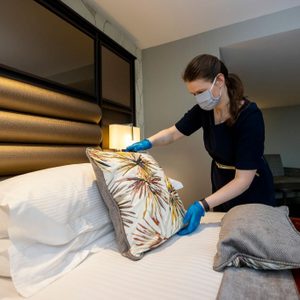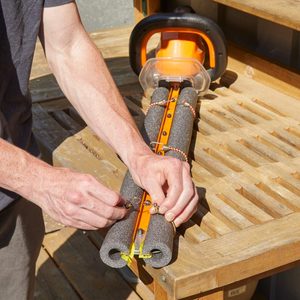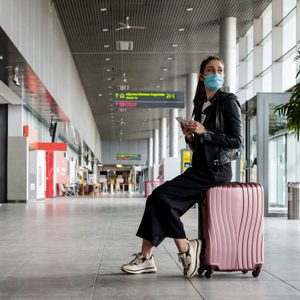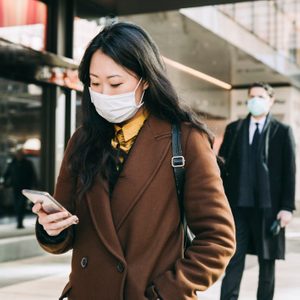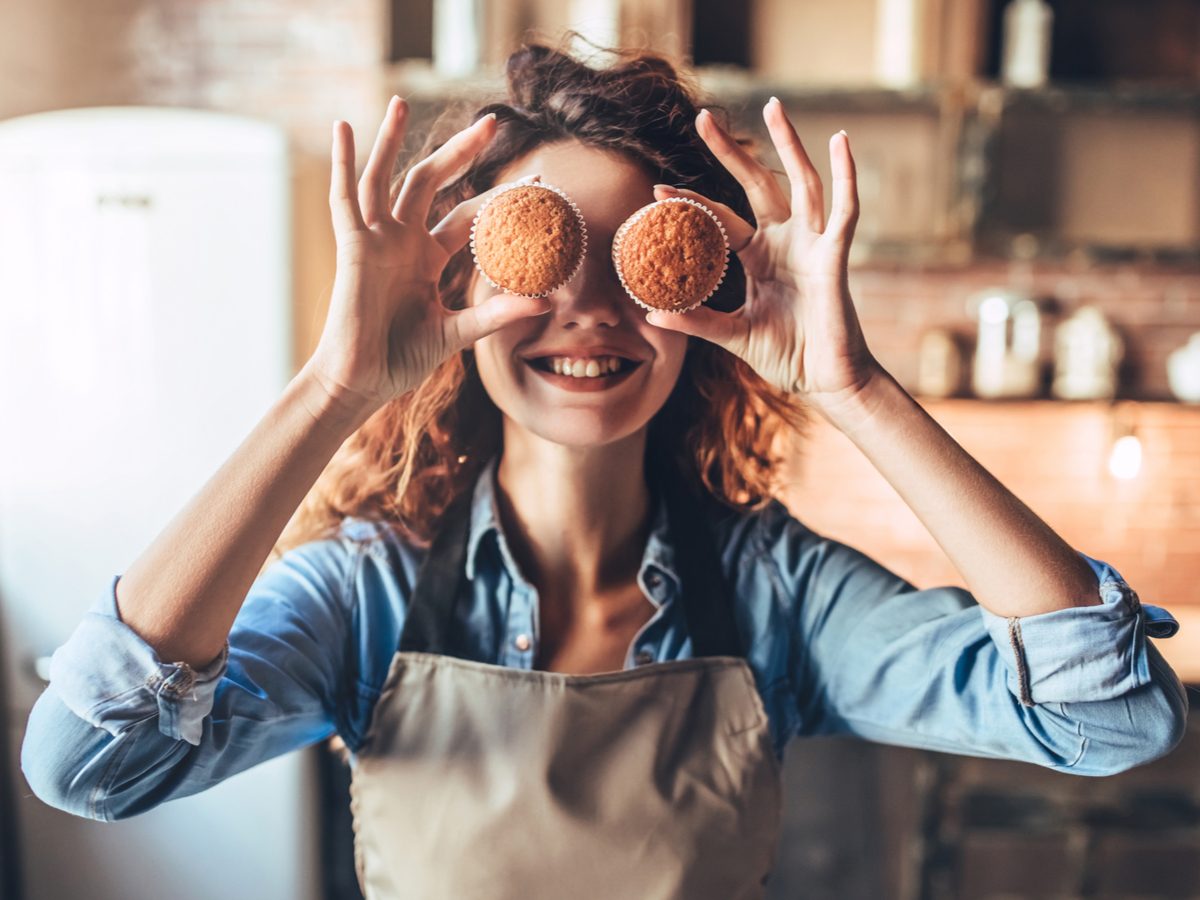
It’s no surprise that banana bread has become the star of 2020’s stress baking cycle. It’s a warm hug wrapped in cinnamon, foolproof to make and you don’t even need to hunt down yeast. But have you considered why we’re all developing a baking obsession? It has to do with your brain waves—and the blissful escape that may or may not involve Bundt pans.
Baking helps you focus
You’d think a pandemic and quarantine would be a time for slowing down and concentrating on what really matters, like binge-watching Netflix Canada. Alas, most of us are multi-tasking our behinds off, relocating our offices to our living rooms while becoming overnight homeschool teachers. That’s why channelling your focus on one thing, otherwise known as mindfulness, can be a necessary break for both your brain and body.
Harvard Medical School says mindfulness “teaches people to live each moment as it unfolds. The idea is to focus attention on what is happening in the present and accept it without judgment.” Allow yourself the time to bake without a deadline. Slowly measure each ingredient and notice its texture, colour and smell. You should make baking about the journey, not the destination.
Certain scents decrease stress levels
A study from the National Library of Medicine shows that the scents of lavender and rosemary can decrease the cortisol levels in your body. Why is that important? Cortisol is also known as the stress hormone—too much of it has been shown to increase anxiety and depression.
You can bake with a soundtrack
Just as most of us work out to music, syncing our lunges with the beat of a song, music can also provide the rhythm we need to mash bananas, knead dough or whisk eggs. If your thoughts feel like they’re jumping all over the place, music may be the thing you need.
Research out of Stanford University found that brain waves resonate in time with different rhythms of music—slower beats can put you into a more meditative state while faster beats will amp up (no pun intended) your concentration level. The University of Nevada says the music that may reduce stress the best is Indigenous, Celtic, Indian stringed-instruments, drums and flutes.
Baking is like art therapy
That’s right—even if you could be considered for the TV show Nailed It!, where home bakers try and [spoiler alert] fail to recreate Pinterest-worthy deserts, just participating in a crafty activity can reduce your stress level, according to a study from the National Institutes of Health. Participants in the study said they found art-making to be “relaxing, enjoyable, helpful for learning about new aspects of self, freeing from constraints… and about flow/losing themselves in the work.”
Generosity makes you happier
So you’re on your fifth loaf of banana bread and running out of counter space. You could freeze it, sure, or you could drop it off a neighbour’s house or gift it to that selfless courier who delivers your Uniqlo order.
Researchers at the University of Zurich in Switzerland found a link between being generous and an increase in brain activity that accounts for positive feelings, what many would call a “warm glow.”
Happiness can be hard to come by. From owning a dog to wearing sunglasses, these tips can boost your mood—and your well-being.
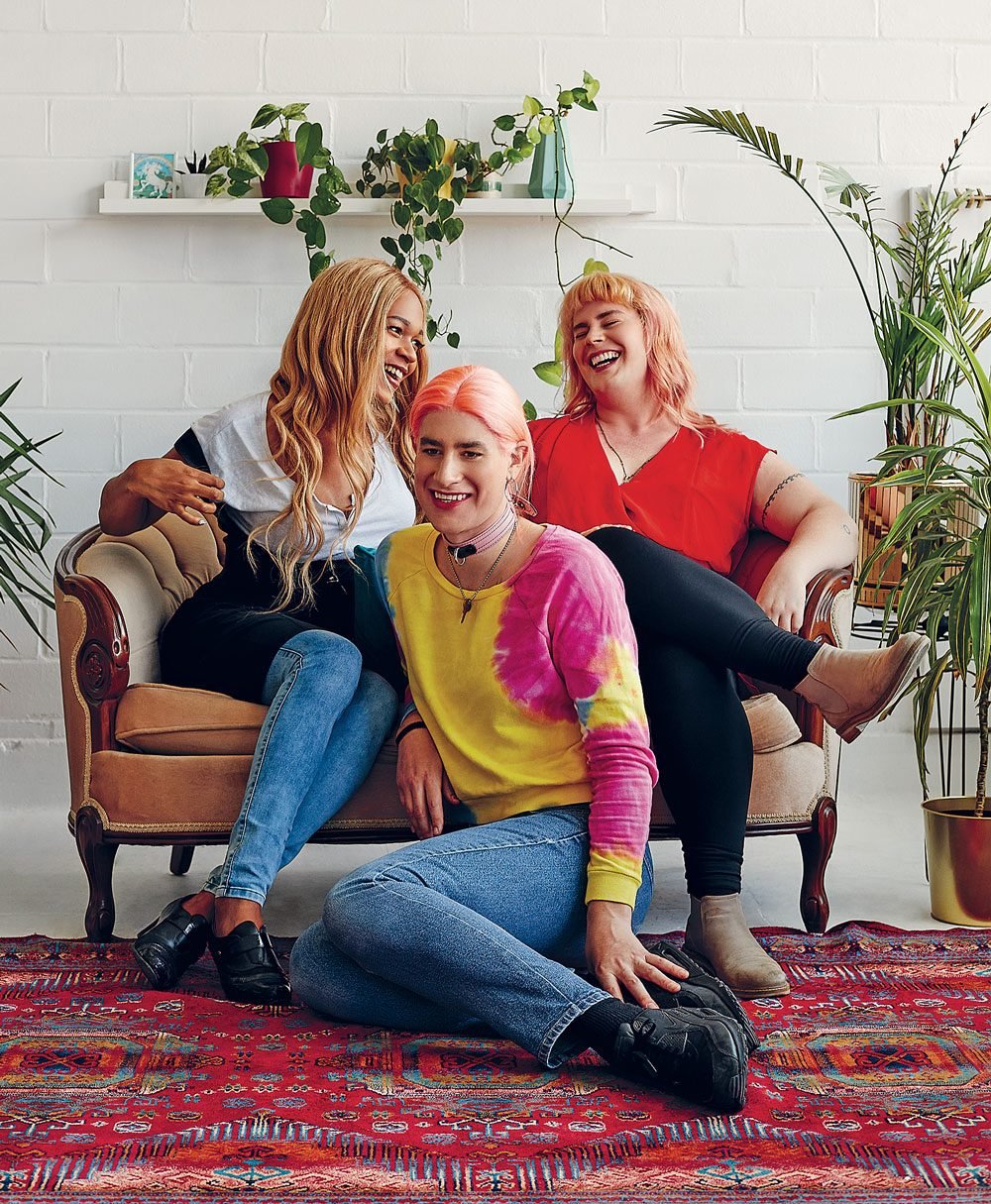
Canada’s transgender community has made many strides in the past decade: securing rights protections, getting elected to office and seeing themselves represented by central characters on popular shows. But it’s still far from easy to be trans in Canada. According to recent reports, 74 per cent of trans youth say they’ve been verbally harassed; in Ontario, the unemployment rate for trans individuals was nearly three times as high as the national rate; and trans people earn a median income of only $15,000 per year.
In 2015, three trans Montrealers, Estelle Davis, a comedian and writer; Lenore Claire, a stage performer and bartender; and Elle Barbara, a musician and community organizer, decided that it was up to them to create an effective support system for other trans people. Their organization, Taking What We Need, would provide discretionary funding to low-income transfeminine people—money for rent, food, transition-related costs or anything else they need to thrive.
The women knew from experience that the process of transitioning itself could be expensive. Facial feminization surgery, clothing, makeup and meetings with therapists, which many women seek out during their transitions, can be prohibitively expensive. Even laser hair removal, which some trans women seek for their faces, can cost four figures.
Claire, Barbara and Davis started by throwing a Titanic-themed party to raise funds for an at-home laser hair removal machine, which they’d lend to other women. They decorated each room to look like a set from the movie, and more than 100 people attended, bringing in $1,200. They were so overwhelmed by the response, they decided to forgo buying the machine and donated the money directly to low-income trans women they knew were in need.
TWWN has since hosted comedy and bingo nights, movie screenings, picnics and clothing swaps. All proceeds generated at the door are distributed to transfeminine people through their funding program. Before COVID-19 social distancing took effect, one of their monthly parties, Trans Amour, served as a social with an open mic and dancing. While attendees are predominantly LGBTQ+ people in their 20s and 30s, the crowd has steadily diversified. “People travel from all over to attend. We have had people fly in from Calgary or drive from Toronto,” says Davis. “It’s rare to see spaces that support trans women in this way.”
In addition to fundraising drives, the organization receives donations from individuals and funding from the Quebec Public Interest Research Group at Concordia University. “I don’t think we could ever continue running without the support and labour of a whole community,” says Davis, who spends about 20 hours a month coordinating their events and donations.
Today they’re able to provide funding to two trans women a month, while there are generally 40 on the wait-list. In 2017, Anaïs Zeledon Montenegro, who is 60 years old and an immigrant from Costa Rica, was one of those women. After transitioning, she was left unable to change her legal name until she became a citizen. And without documentation that reflected her transition, she had trouble securing a job and covering her rent.
TWWN provided her with a $700 lump sum. That helped her keep her apartment. She later took a job as a counsellor at Action Santé Travesti(e)et Transsexuel(le)du Québec, an organization that aims to promote the health and well-being of trans people.
Montenegro was inspired to see women within the community supporting each other. “It’s heartening to know that the organization gives others the same help I was able to receive.
Next, learn about the Toronto lawyer who’s transforming her industry by mentoring young Black women.
They’ve been called the deadliest creatures on Earth (aside from humans, that is). And while it’s hard to imagine that your average mosquito—just a few centimetres long and weighing a couple of milligrams—could inflict major carnage, the biting, blood-sucking females of some 100-plus species are vectors for any number of potentially fatal diseases. Mosquitoes carrying malaria kill 435,000 people around the world every year according to the U.S. Centers for Disease Control and Prevention (CDC).
So, what would happen if we managed to eradicate every one of these insects from the planet? There’s good news and bad news.
It’s a slippery slope
Stanford bioethicist Henry Greely calls for caution—and a lot of it—when it comes to plotting the extinction of any living thing. “I would want there to be some consideration and reflection, and a social consensus, before we take that step,” he told Smithsonian Magazine. His concern? If we say yes to eradicating mosquitoes, then why not rats? Or birds? Or bats? Or any other animal someone decides is problematic at any given time?
Bird and bat species could suffer
Speaking of bats and birds: These are animals that rely heavily on mosquitoes, feasting on them to make up a sometimes considerable portion of their diet. A little brown bat, for example, can eat up to 1,000 mosquitoes in just one hour. And in the Arctic tundra, reports Smithsonian, spring hatchings of billions of mosquitoes “are a significant food resource for birds.” Bruce Harrison, an entomologist at the North Carolina Department of Environment and Natural Resources in Winston-Salem, told Nature “that the number of migratory birds that nest in the tundra could drop by more than 50 per cent without mosquitoes to eat.” (Don’t miss these facts about animals you’ve got all wrong.)
So long, little fish?
It’s not just warm-blooded animals that would be at risk if we wiped out mosquitoes. Plenty of fish and other insects feed on mosquitoes and their larvae. As entomologist Grayson Brown told Gizmodo, “Mosquito larvae are very important in aquatic ecology…and the loss of that food source would cause their numbers to decline as well.” Furthermore, he says that the ecological damage that would be necessary to wipe mosquitoes out, i.e., “draining swamps/wetlands, applying pesticides over wide areas…would make eradication not worth it unless there was a very serious public health emergency.”
Pollination problems
Did you know that some mosquitoes actually perform pollination services, just like bees and butterflies? By flitting from flower to flower—including orchids in some northern regions, according to the U.S. Forest Service—they carry pollen from one to the other on their feet. Wiping mosquitoes out, writes Nature, might “leave a predator without prey, or a plant without a pollinator.” Although, the imminent collapse of essential food-pollinating bee species would be much worse news. Here’s what you can do to save the bees.
Changing migration patterns
“Mosquitoes consume up to 300 millilitres of blood a day from each animal in a caribou herd, which are thought to select paths facing into the wind to escape the swarm,” says Nature. “A small change in path can have major consequences in an Arctic valley through which thousands of caribou migrate, trampling the ground, eating lichens, transporting nutrients, feeding wolves, and generally altering the ecology.”
Unleashing the power of CRISPR
One less apocalyptic way scientists are seeking to solve the mosquito problem is by genetically altering them with a relatively new and optimistic technology called CRISPR, rather than eradicating them altogether. But critics maintain that this presents its own ethical dilemma.”We can remake the biosphere to be what we want, from woolly mammoths to nonbiting mosquitoes,” Greely told Smithsonian. “How should we feel about that? Do we want to live in nature, or in Disneyland?” Also of concern to some: What if terrorists got their hands on mutated bugs and used them to engineer epidemics? (Learn how to spot the signs of a mosquito bite allergy.)
More humans…
With so many people succumbing to mosquito-borne diseases every year, one unquestionable result of eradicating all these flying agents of potential death would be that more people would live longer. “Countries freed of their high malaria burden, for example in sub-Saharan Africa, might recover the 1.3 per cent of growth in gross domestic product that the World Health Organization [WHO] estimates they are cost by the disease each year, potentially accelerating their development,” reports Nature.
…Less suffering
There’d be fewer people suffering and surviving the ill effects of malaria, Zika, and the like, as well. As WHO malaria scientist Jefferey Hii told Nature, this means “less burden on the health system and hospitals, redirection of public-health expenditure for vector-borne diseases control to other priority health issues, less absenteeism from schools,” as well as just plain less misery overall.
Other species would fill the gap
Finally, many scientists have speculated that, since no mosquitoes are actually keystone species on which whole ecosystems depend, other insects would step in to fill the void their absence would create. “[I]n many cases, scientists acknowledge that the ecological scar left by a missing mosquito would heal quickly as the niche was filled by other organisms,” postulates Nature. “Life would continue as before—or even better.” While scientists continue the debate, to cut down your exposure in the meantime, try landscaping with some of these mosquito repellent plants.
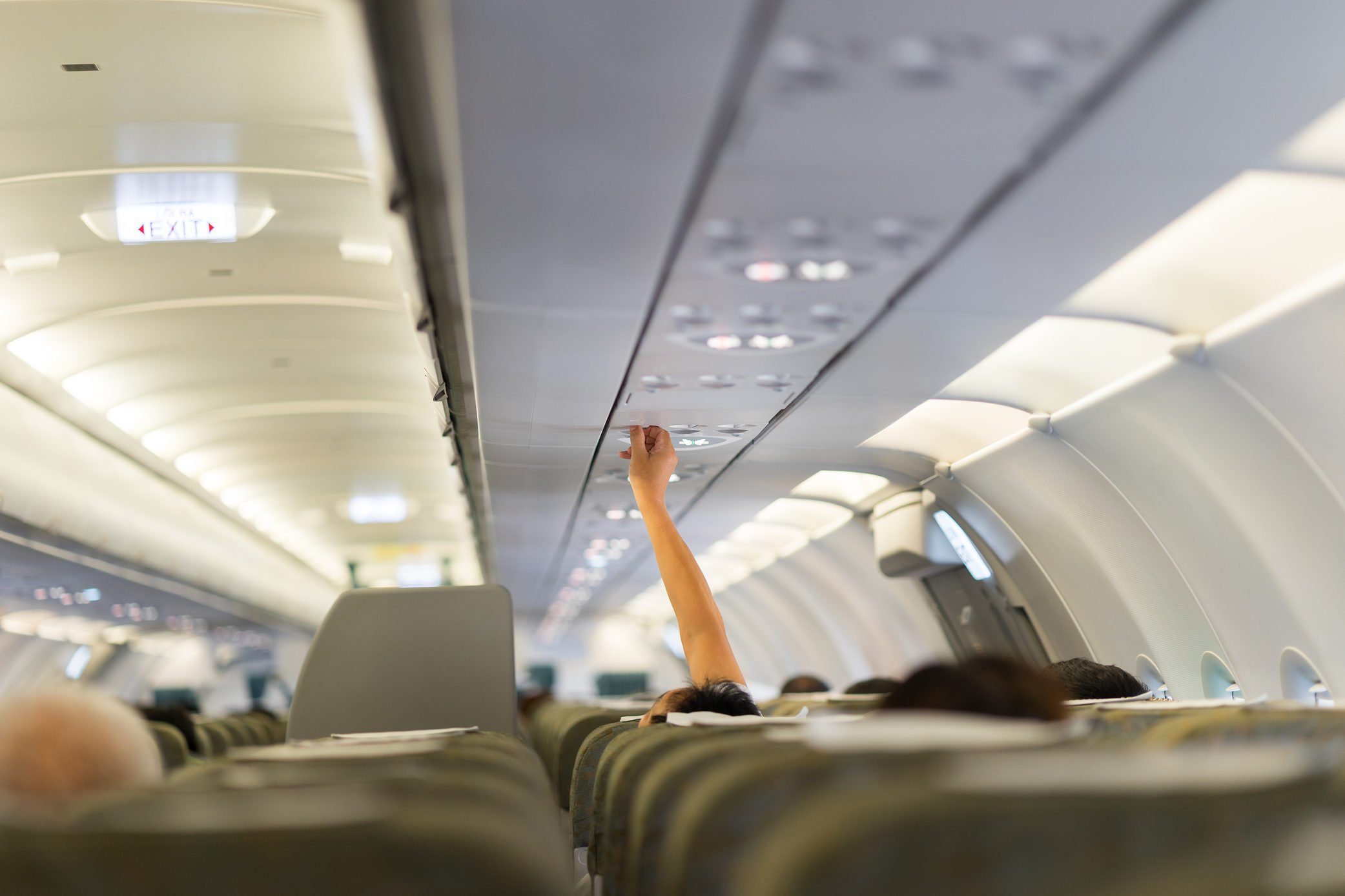
There are lots of factors to consider and questions to ask if you’re planning on getting on a plane during the COVID-19 pandemic. How safe will you be at the airport and on the plane? What new rules will you have to follow? There’s one common concern, however, that you don’t need to worry about—one that’s been making fliers nervous since long before the coronavirus pandemic. It involves the air inside the planes. Specifically, that the air is crawling with germs, making you very susceptible to getting sick during your flight—especially now, with a deadly airborne virus running rampant.
What’s the fear here?
This is one of the most popular myths about airplanes because, when you think about it, it’s logical. Airplanes are pressurized, completely enclosed vessels flying through the sky, often for many hours. So the air inside them must be recycled, right? And if the same air is floating around you and your fellow passengers for hours on end, it must be loaded with germs, right?
So, is it true?
It’s not! You don’t have to worry about the safety or cleanliness of the air around you while you’re flying. Perhaps surprisingly, there is fresh air coming into the planes, according to Scott Keyes, founder and chief flight expert at Scott’s Cheap Flights. “Airplanes aren’t hermetically sealed environments,” he explains. “During a flight, fresh air from outside the plane is being continuously circulated into the cabin through complex vents in the engines.”
But the air isn’t all fresh—yes, some of it is recycled. As Condé Nast Traveler explains, it’s “some fresh air with up to 50 per cent [recycled] cabin air.” But that doesn’t mean it’s unclean. The majority of airlines equip their planes with hospital-grade filters specifically for the purpose of keeping the air clean. “These High Efficiency Particulate Air (HEPA) filters cycle the air every few minutes, capturing 99.97 per cent of airborne particles,” Keyes says.
Most of the time, your airplane is equipped with germ-trapping filters that keep the air as clean as possible—and that’s pretty clean. “Because of these onboard filters, researchers have found that airplane air is as clean or cleaner than the air in offices, schools, and other indoor settings,” Keyes says. That’s good news—especially now.
The majority?
Yes, not all airplanes have them. The World Health Organization says that “most modern aircraft” have these filters, but if you’re on a short regional flight, for instance, your plane might not have one. “While nearly all mainline jets in the United States have HEPA filters, according to a recent American Airlines press release, there is no federally-approved HEPA filter available for Embraer 140/145 regional jets,” Daniel Burnham, flight searcher for Scott’s Cheap Flights, told Reader’s Digest.
Luckily, though, you can pretty easily find out if the plane you’re on has these filters, he says. “First of all, you can always check the seat map for your flight when you make a new booking or review an existing reservation—most airlines will tell you what kind of plane is operating the flight,” he explains. “If you’re flying on a plane with 70 seats or more, you can be confident that it will have HEPA filters installed.” He says that Google Flights is also a helpful resource; you can find the type of aircraft you’ll be on “if you click on the drop-down menu for each flight segment.”
It’s not completely risk-free
While this means that the common worry about germ-loaded plane air is unfounded, it of course doesn’t mean airplanes are completely safe. There’s always a risk of catching something on a plane, even when COVID-19 is not an issue. “Planes, like most places, will never be 100 per cent safe,” Keyes warns. “Though fresh air and filters help, you’ll still be sharing an indoor space with quite a few people for an extended period of time. If a sick person sitting next to you coughs, fresh air and HEPA filters aren’t great armour.”
Next, make sure you avoid these common face mask mistakes.
The simple trick for cooking corn on the cob
It’s summer, which means it’s the best time of year to eat some delicious corn on the cob. If you’re having a barbecue, you might be making some grilled corn (and you should try one of our tasty topping recipes). But if you’re in the mood for traditional boiled corn on the cob, you’ll want to check out this corn “upgrade” from TipHero. You won’t believe the difference it’ll make—and all it takes is two simple ingredients.
When the water is boiling, add some milk and butter to the pot before adding the corn. (TipHero recommends one cup of milk and one stick of butter.) It’ll make the corn sweeter and more flavourful—and it allows you to skip a step, too. Because of the butter from the pot, the corn will already have a nice buttery taste. So instead of taking the time to slather the cob with a pat of butter, you can dive right in and take a bite.
The whole process takes only 13 minutes from start to finish. Check out the full recipe on TipHero. It’s hardly more than a simple tweak to the way you usually cook corn, and we promise you’ll never go back! TipHero recommends sprinkling the corn with salt or pepper for the ultimate taste. Bon appétit!
Round out your dinner with one of these easy summer dessert recipes!

Buy, sell and donate during the pandemic
If there’s anything that will inspire a person to clean the excess junk out of their home, it’s being trapped inside it for months on end. The question is what to do with it all.
Donating your used clothing, books, and kitchenware to a thrift store or charity is a good idea—in theory. It can help people in need save money, it’s good for the planet to reuse, and thrifting can be an exciting and affordable way to score some true gems. (This writer recently found a pair of vintage Dior sunglasses for $3.49 at Value Village.)
It can be tempting to drive straight to a big box donation centre and get rid of all your clutter at once. But it isn’t always the most environmentally friendly option. Donation centres receive a high volume of stuff that can’t be resold, and much of it ends up in the landfill—or worse, it’s shipped overseas and ends up in another country’s landfill. Also, many places still aren’t accepting donations, and a traditional garage sale can feel risky right now (though it can be done safely—more on that below).
Luckily, there are still easy and safe ways to both rid yourself of unwanted things and find new treasures. Here are some common sense tips for the bargain hunters among us.
How to safely sell and donate
Sell or donate online: Giving or selling items directly to people who want and need them is the best way to go. Check out the local chapter of your favourite online marketplace, such as Craigslist, Facebook Marketplace, or Kijiji, and have a look at the free section. People post items they’re giving away for free, and also request free items they’re in need of. Often people will request items—such as furniture and housewares—when they’re in a life transition stage and can’t afford whole new setups. Local organizations supporting refugees are often looking for household items and furniture, too.
Why lug your old microwave to a store when you could give directly to a person in need? If you don’t see people looking, create your own ad. Include the condition of the item, its location, dimensions, and any other relevant specs. Whenever I post items for free, people usually come within a day to take them off my hands. Recently, I made a post for a free shelf and someone arrived an hour later to pick it up. Organize contactless porch or trunk trades to ensure safety. You leave the item out for someone to grab, and they send you money by e-transfer or leave cash.
Kijiji and Facebook recommend avoiding meeting in person, if possible. If you do need to meet to make the sale, such online marketplaces recommend physical distancing of six feet, like everywhere else these days. And, it’s always good etiquette to clean an item before a sale or donation with disinfectant.
Donate to organizations in need: Another solid bet is to check with local organizations who support people in need. Toronto alone has many organizations seeking donations, including Kapit-Bisig Laban, a mutual aid group for Filipinos affected by COVID-19, the Parkdale Activity-Recreation Centre and New Circles, which caters to women and girls. Check with shelters and other organizations in your area to see what they’re accepting. Also, see what mutual aid groups in your area have cropped up to support people facing losses during COVID-19.
Hold a contact-free yard sale: Another option is a contactless yard sale. Whether or not you go this route will largely depend on rules for your area and the number of active COVID-19 cases. Some jurisdictions have only recently lifted bans on yard sales; others haven’t at all. Check with your municipality to determine what’s recommended locally. Once you’re in the clear to go ahead—and you feel comfortable doing so—hold your sale outdoors, and make it contact free.
If you or your potential browsers don’t want to exchange cash, set up a sign with your email so people can e-transfer you. Otherwise, have a bucket where people can drop their change and cash. Provide sanitizer and ask that people wear masks—you may even want to consider providing some at the entry to the sale, if you can. And, of course, clean items before setting them out for sale.
How to safely bargain hunt
Buy from online marketplaces: COVID-19 spreads through respiratory droplets, and it’s unlikely you’ll get the virus from a contaminated package or item. This summer, buying directly from another person is a safer bet than navigating a crowded or poorly ventilated thrift store—and even with yard sales, you can’t guarantee everyone will follow safety precautions.
Before going to check out an item you’d like to buy from an online seller, make sure it’s something you really want. Ask the right questions, like the item’s condition and size. Before you make up your mind, don’t be afraid to ask for more photos or even video instead of viewing the item in person. On that note, as satisfying as bargain-hunting may be, you may also consider whether you really need to upgrade your tchotchkes or vintage denim collection right now.
Go to a contact-free sale: If you’re set on the yard-sale experience, have a look on your local classified pages and see what you can find. You’ll want to stick to outdoor yard and church sales, where ventilation is good and the risk of transmission is lower. Pack your sani and mask, keep your distance, and go at it—but don’t touch anything unless you’re sure you want to buy it.
Once your treasure is safely at home, clean it immediately with disinfectant, and avoid touching your face until you’ve washed your hands. If you’re extra worried, you could even “quarantine” the item in your trunk or a bag for at least 48 hours.
Brave a second-hand shop: If you can’t find what you need online and need to head to a second-hand shop, the same safety rules apply as anywhere else. Just remember some businesses don’t have strong protections in place against COVID-19. While masks are suggested, they’re not required in all jurisdictions. Thrifting also requires touching lots of items as you sift through and assess them.
And while thrifting may often feel like a competitive sport, try to be a team player during the pandemic. Follow government directives from the chief public health officer and wear a mask if you can to protect others from any germs you may unwittingly be carrying. Use the provided sanitizer and gloves if available, and try to avoid touching things. Good luck, and may you find that holy grail bargain item you’ve been searching for!
Next, find out what to cut out of your budget during the pandemic.
Hair salons and barbershops are beginning to reopen across Canada, and while that’s music to the ears of those who struggled through DIY haircuts at home or opted not to dye their own hair, salons aren’t going to have the same leisurely spa vibe they once did. “In the United States and Canada, each state and province issues recommended guidelines,” says Jeff Alford, CEO of the CBON (Cosmetic Brands of North America) Group in Toronto. “Up until now, you’d never feel scared to have a facial done or go get a haircut, but now the public is feeling that the beauty industry is one of the most dangerous places to go. We need to step up in our industry and get educated, and the public needs to get educated, too.”
So, how can you tell if a salon is stepping up during the pandemic? Check for these seven red flags. If you encounter them, it might be time to find a new salon.
There are no masks in sight
For the safest environment for all, everyone in the salon—stylists and clients alike—should be wearing a mask. The mask protects those around you from your germs in the event that you are asymptomatic but have the virus, and it can also help prevent you from inhaling aerosolized respiratory droplets. One recent Japanese study found that coronavirus cases are nearly 19 times more likely to be transmitted in indoor spaces than outdoor ones.
Besides maintaining a two-metre distance from others, masks are one of the most effective ways to slow the spread of coronavirus. Case in point: In May, two Missouri hairstylists had close contact with 140 clients before they were aware they had COVID-19 but while they were experiencing illness symptoms. Both the clients and the stylists wore masks, and none of the clients ended up testing positive.
Still on the fence about donning a mask? These eye-opening facts will convince you that it’s a really good idea to wear one.
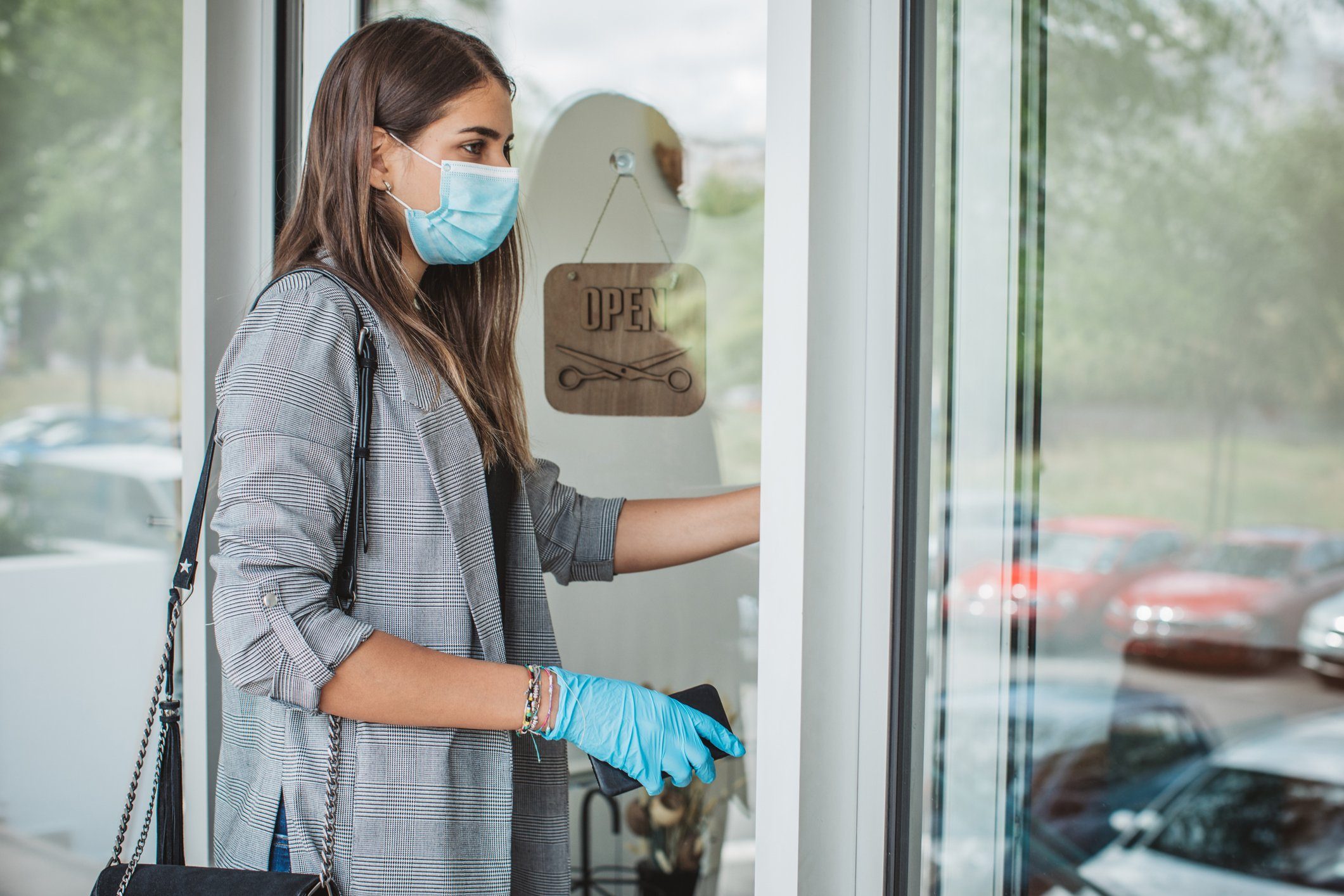
You’re not seeing any sanitization procedures in practice
In the past, stylists and salon staff would sanitize tools between each client, but now they should be disinfecting chairs (including hair-washing-station chairs) and washing their hands between each guest as well, says George Papanikolas, a MATRIX celebrity colourist in New York City. Alford advises all stylists to wash hands and disinfect at a time when clients are watching so they can see with their own eyes the safety steps in place.
All those sprays and disinfecting wipes don’t come cheap. As a result, some salons are adding a safety surcharge or fee to help cover the costs of these products and other new equipment, such as plexiglass barriers between stations.
Clients are congregating in the waiting area
To help limit contact with others, salons should stagger appointments so you won’t meet others in the entryway or exit, Papanikolas says. Safe salons will kindly ask you to wait outside or in your car until you receive a call or text letting you know that your chair is empty and has been disinfected and that the stylist is ready for you.
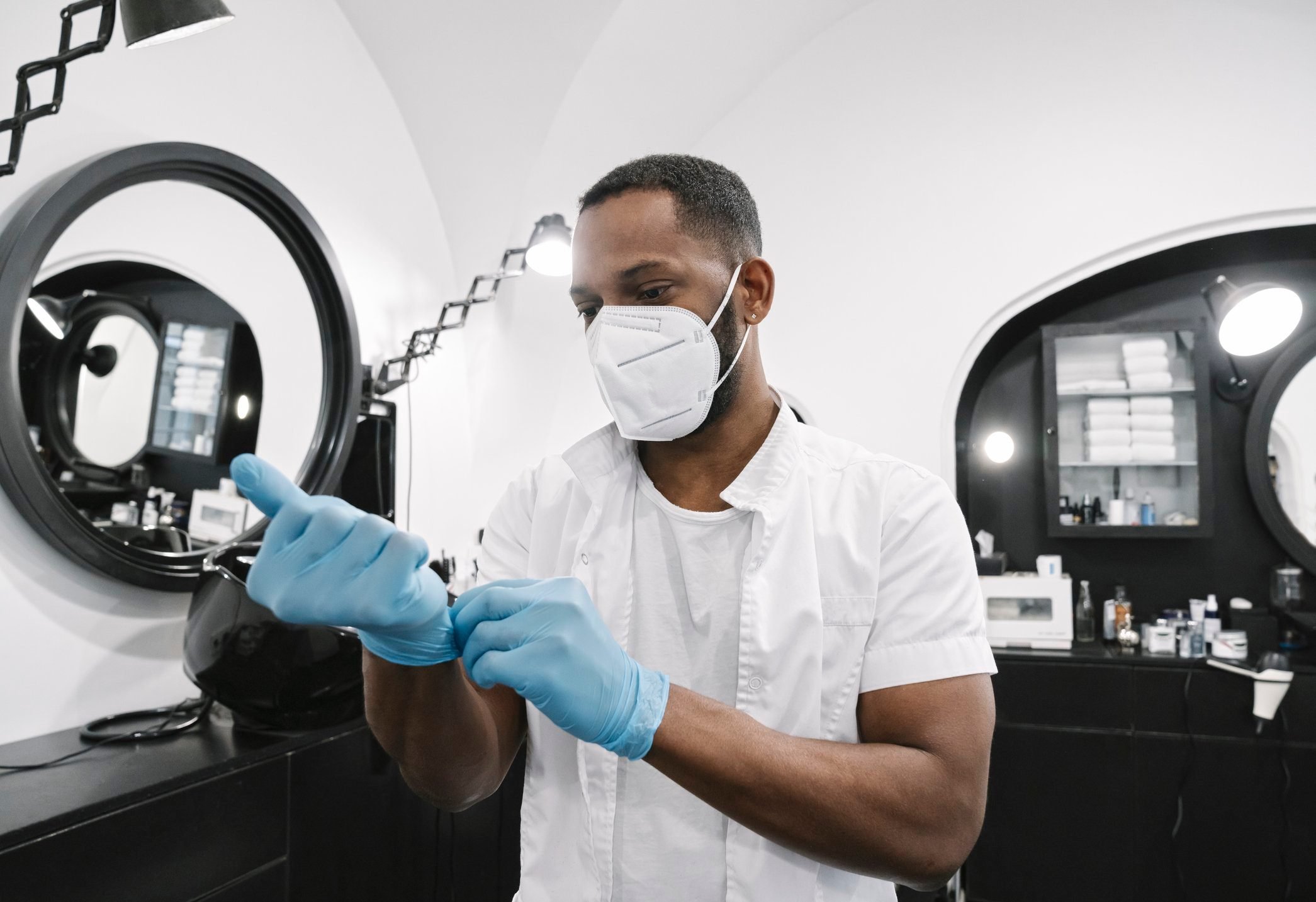
The salon didn’t contact you about new safety procedures
Salons should be forthcoming about this information. If you didn’t receive an email about them or speak to someone ahead of time, check the salon’s website or social media page. If there’s nothing, there’s a problem. Since it’s challenging to know how buttoned-up a salon’s sanitation is before you enter the premises, Alford suggests that clients call and ask about the following things to see if they’re playing it safe:
-
What social distancing measures have been enacted?
-
Are all staff and clients required to wear masks? (Here’s how to make a DIY face mask—no sewing required!)
-
Are you using hospital-grade disinfectants?
-
How often do stylists wash their hands? (Find out 10 hand washing mistakes to avoid.)
“We’re encouraging the public to become proactive,” Alford says. Still, it’s even better if the salon shares this before you have to ask. “From a consumer’s point of view, if a business that I’m supporting hasn’t posted any COVID-19 precautions on their website, social media, email newsletters, or on their front doors or windows, that immediately would be a red flag for me,” says Tricia Rivas, “chief dream operator” and owner of Trixies Salon in Des Moines, Iowa.
It’s as crowded as ever
As mentioned earlier, salons should alternate appointment times and allow for at least two metres between other stylists and clients, Papanikolas says. Plexiglass barriers between stations are now more common, as well. If a salon is safe, you will see a redesigned space with far fewer people in a room at once, Rivas says.
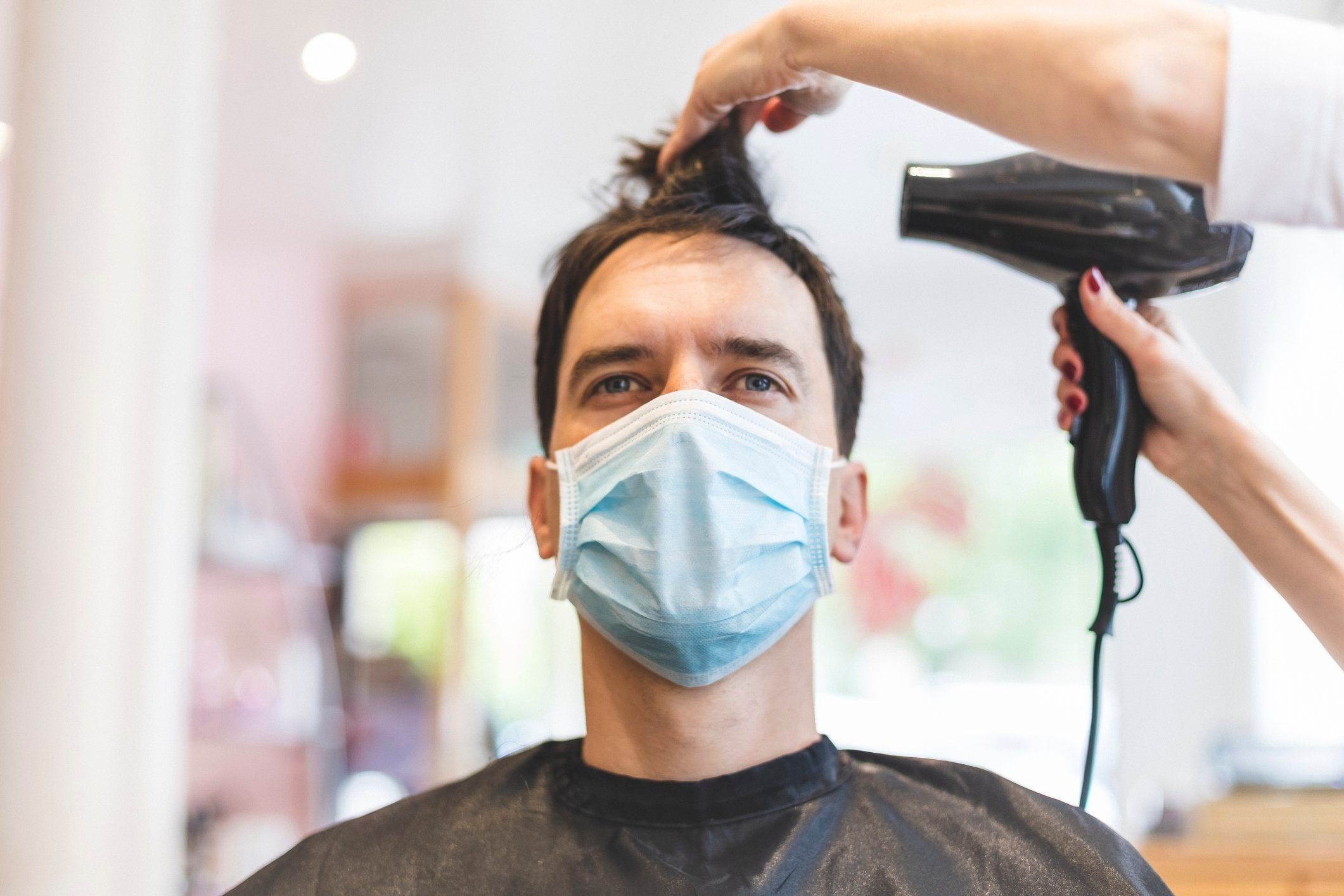
Hair dryers are in frequent use in large spaces
“High-powered dryers were great pre-COVID-19, but no longer,” Alford says. That’s because we’re learning that, while unlikely, a blow-dryer may accelerate the spread of respiratory droplets from an infected individual to others, according to Cedars-Sinai health experts. Some states, including New Hampshire, have made salon blow-dry services off-limits. In provinces and states where it is allowed, “blow-dry rooms or sections may be opened so the droplets aren’t spread to other clients and stylists,” Alford says.
Some salons, including Rivas’ Trixies, do not offer blow-drying or styling at this time—both as a safety precaution for airflow and to reduce exposure time to others within the salon space.
Guests are allowed to bring kids or other companions
Clients should be instructed to arrive with as little baggage as possible, Alford says. That means literal bags, such as purses and backpacks, as well as other people, including kids and spouses. The fewer things and people in an enclosed space, the better to reduce the potential transmission risk. A safe salon should call or email about all of these capacity restrictions in advance of your appointment.
Next, find out the five places that present the highest risk for catching COVID-19.
As temperatures and levels of frustration continue to rise during the pandemic, wearing face masks has become a hot topic of discussion. Masks may not be the most comfortable thing in the world, especially in the summer months, but they’re necessary right now to help prevent the spread of COVID-19. That said, while the Canadian government recommends face masks for most people, they do note a few exceptions, stating that “non-medical masks or cloth face coverings should not be placed on young children under age 2, anyone who has trouble breathing, or is unconscious, incapacitated or otherwise unable to remove the mask without assistance.” (Here’s how to make a DIY face mask—no sewing required!)
Fortunately, masks aren’t the only way to cover our faces. Could wearing a face shield be a good alternative to wearing a mask? Is it possible that it could even provide better protection? Here’s what the experts have to say.
Why we need to cover our faces during the pandemic
There’s a fair bit of misinformation about coronavirus out there, but one thing isn’t up for debate. “We know for sure that COVID-19 spreads through viral droplets (from direct exposure to a cough or sneeze of an infected person) and prolonged contact with an infected person,” says infectious-disease specialist Sandra Kesh, MD, the deputy medical director at Westmed Medical Group in Westchester, New York. While much of the information regarding COVID has changed since the beginning of the pandemic as scientists have learned more about it, Dr. Kesh wants to clarify that experts now suspect the virus can be spread via aerosols, if someone sneezes or coughs. “When this happens, particles can get in the air and be inhaled,” she explains.
And wearing a mask is important not only to protect yourself but also to protect others. Studies show that masks help prevent you from transmitting coronavirus germs to those around you—something that’s especially important since you can be contagious before you start showing symptoms and even when you’re fully asymptomatic and never come down with full-blown symptoms. Here are more eye-opening facts that will convince you to wear a face mask.

Do experts prefer face masks or face shields?
So, now to the question at hand. The Centers for Disease Control and Prevention (CDC) in the U.S. doesn’t recommend face shields over face masks (or vice versa), and there are no definitive studies proving one choice is better than the other for COVID-19 prevention. But some physicians laud the efficacy of shields as an option for protection. In a recent opinion piece in JAMA, Eli Perencevich, MD, a professor of internal medicine and epidemiology at the University of Iowa Carver College of Medicine, along with two of his colleagues, explained that face shields appear to significantly reduce the amount of inhalation exposure to the influenza virus, which, like COVID-19, is a droplet-spread respiratory virus. A simulation study found that face shields reduced immediate viral exposure by 96 per cent when worn by a health care worker within 18 inches (45 centimetres) of a cough.
That said, the CDC, WHO, and most doctors endorse masks as a preferred line of defense. Why? “Masks offer a better way of preventing droplets from leaving the mouth or nose of someone who might be infected,” explains Dr. Kesh. The problem with a shield is that droplets can still escape from the side and bottom. “Additionally, our main portal of entry for the virus is the nose, so making sure the nose is fully covered will help to create a greater barrier for entry,” she says. Of course, face masks are only effective if you use them properly, so make sure to avoid these common mask mistakes.
Masks have more containment of the mouth and nose than shields do, but wearing a mask isn’t possible for everyone. “For those who cannot tolerate a mask, a shield could be better. But I would encourage my patients to try a few different masks before giving up,” says Dr. Kesh. “Something is better than nothing, but a mask offers better protection than a shield.” Here are some of the issues you should consider when making this decision.
Masks aren’t easy to breathe in
“Although wearing a face shield with a mask is the optimal form of use, face shields are more breathable than cloth masks are,” says Jen Podany, CEO of Bluestone Sunshields. “[For example], our customers in the restaurant industry can quickly move without feeling suffocated while wearing shields.” Plus, Bluestone Sunshields, in particular, can help you avoid strange tan lines from masks. While these shields are currently used as PPE, they were originally designed as sun protection for those with very sensitive skin. That said, not all face-shield brands block harmful UV rays, so do your research first.
Face shields can also be a good choice for those with respiratory issues, as well as people who are doing things that cause them to breathe heavier than normal. “People who are engaged in high-intensity activities, like running, may not be able to wear a cloth face covering if it causes difficulty breathing,” says Abe Malkin, MD, founder and medical director of Concierge MD in Los Angeles. “If you have respiratory issues, you should not risk your own health by wearing a mask.” So, while someone with asthma, for example, may be safe wearing a cloth mask to go grocery shopping, it might not be a smart idea if they’re exercising. In that case, a face shield is a safer alternative.
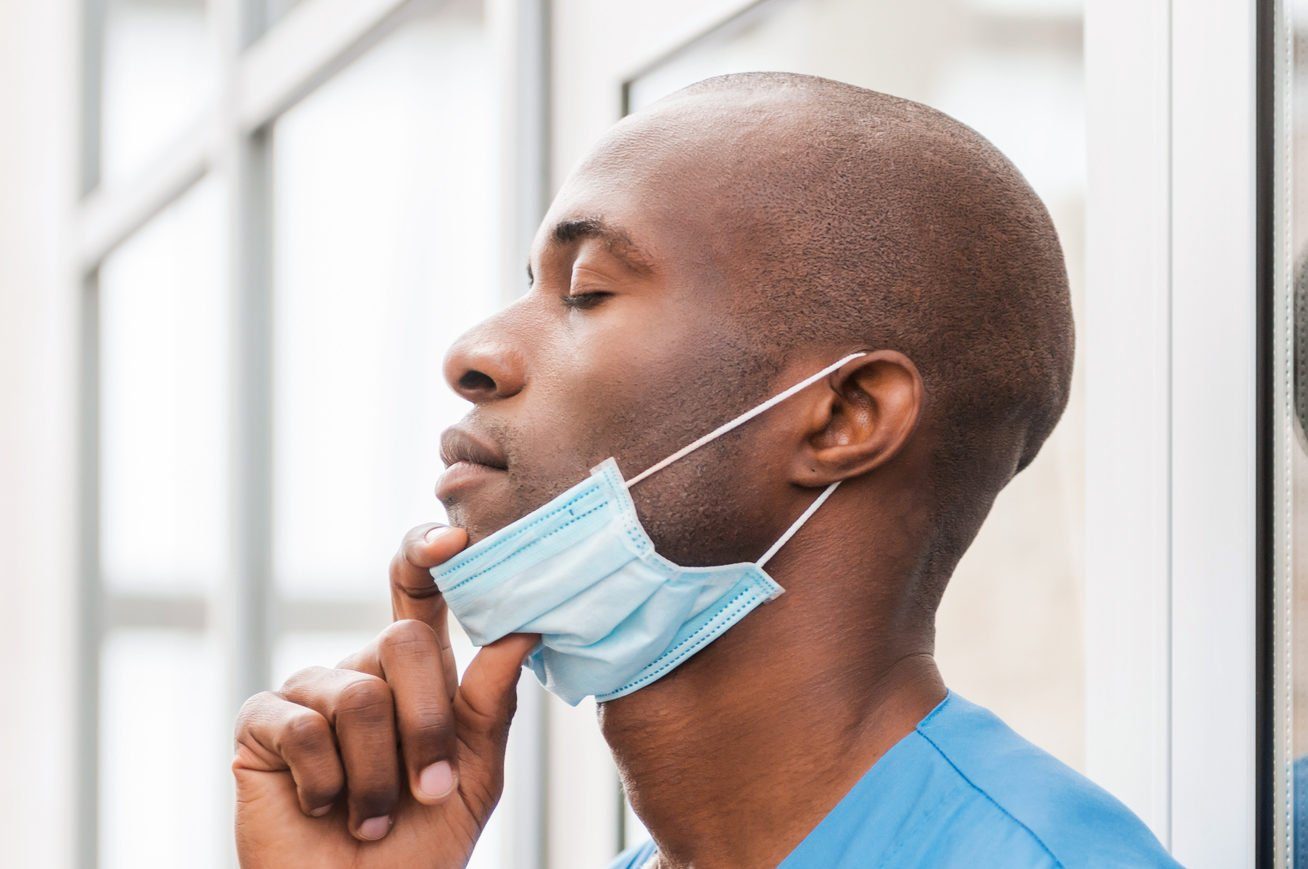
Masks are not recommended for people with some medical conditions
“There are cases like with autism or seizure disorders where a person may be more sensitive than other people to touch and texture and cannot bear the feeling of having the nose and mouth covered by fabric,” says Dr. Malkin. In those circumstances, a shield would be a better choice.
Where face shields have an advantage
One of the biggest problems with masks is that they only cover the nose and mouth, missing the other major entry point for the virus: the eyes. With face shields, the eyes are covered, preventing the absorption of the virus through aerosols as well as hand-to-eye contact. So, if you are a person who often rubs your eyes, a face shield might be a smart idea.
Masks can also cause skin issues, which, while treatable, are an annoyance. “I am seeing an increase in facial breakouts, including acne, rosacea, perioral dermatitis, and irritant contact dermatitis. I definitely think this is from wearing masks,” Sapna Palep, MD, of Spring Street Dermatology in New York City, tells Reader’s Digest. Shields don’t aggravate the skin.
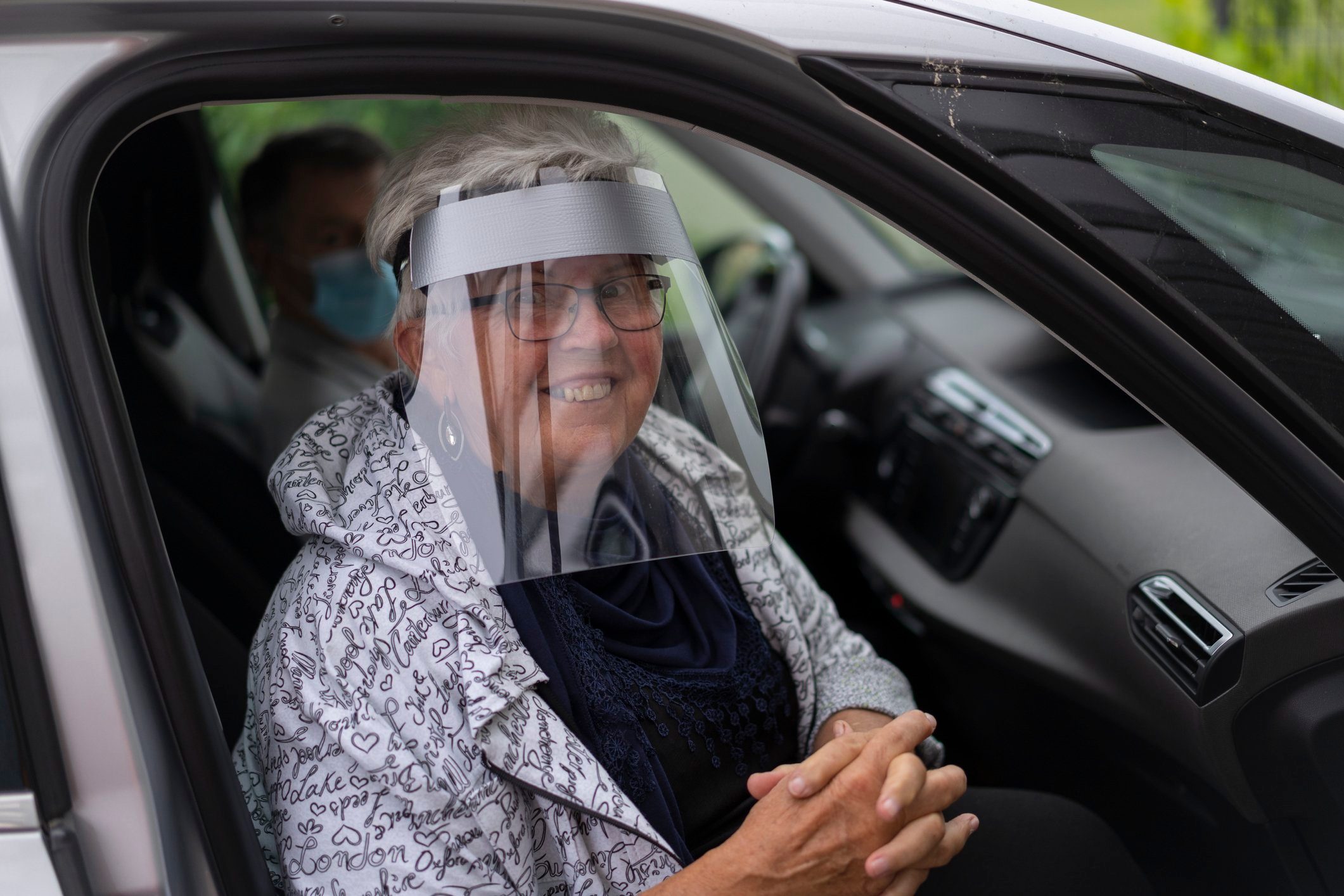
Face shields are easier to clean
Masks should be cleaned at least daily. And if you sweat or exercise in your mask, it’s best to remove it when you’re done with your activity to avoid the potential skin conditions described by Dr. Palep. She recommends cleaning face masks with lingerie wash in a sink or putting them in the delicate cycle and then air-drying them. Either way, washing masks is a chore.
Face shields, on the other hand, are easier to clean than cloth masks because they have a hard surface. “You don’t have to do a load of laundry each time you wear it,” says Podany. But keep in mind that shields need to be cleaned after each use with soap and water. Still, the process is less time-consuming.
Options for kids
As previously stated, the Canadian government guidelines don’t recommend masks for children under the age of two. But as many parents know, older children may be obstinate or pull off their masks. Dr. Malkin suggests “trying to make wearing a mask fun for kids by offering designs featuring their favourite superhero, calmly explaining the need for the mask, and keeping it a bit looser around the nose and mouth.” Dr. Palep also supports kids wearing shields if they won’t wear face masks because it’s better than wearing nothing at all. Plus, children may not be able to exercise caution when touching surfaces or avoiding touching their faces the way adults can, so a face shield designed specifically for kids can help with that issue.
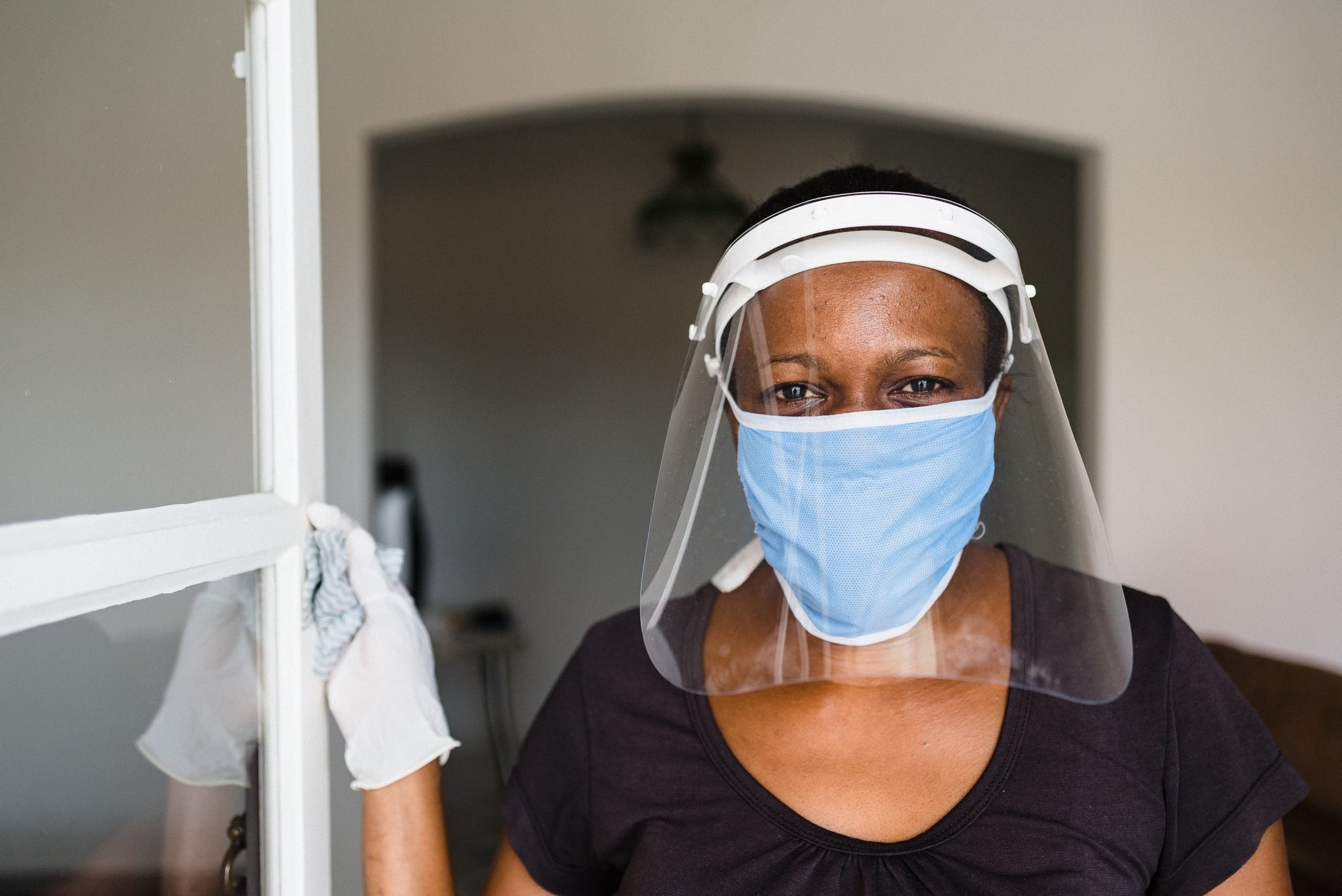
Should anyone be wearing both a face mask and a face shield?
While wearing both a mask and shield provides the maximum amount of protection, most people don’t need to go that far. However, there are some exceptions. Los Angeles–based pediatric nurse practitioner Ersilia Pompilio, RN, recommends them for health care workers. “As one study shows, face shields substantially reduce the short-term exposure for health care workers to large infectious aerosolized particles,” she explains. “Thus, face shields provide a useful adjunct to respiratory protection for workers caring for patients with respiratory infections.”
Keep in mind that if you aren’t a health care worker but you live with someone who is immunocompromised or who has tested positive for COVID-19, then you may want to take additional precautions.
Next, find out the five places you’re most likely to catch COVID-19.

If you find your perennial vines and plants are not growing in the way you thought they would, you’re not alone. There are a few mistakes that people often make with their perennial garden. The good news? You can fix them.
Note: Perennials are plants that grow back each spring, as opposed to annuals that typically grow for one season.
Mistake #1: Not planting for your conditions
Columbine thrives in rich, moist soil, but will languish in hot, dry spots. Ferns like partial shade, while echinacea need full sun. Different perennials have different needs, and it’s important to know the amount of sun and the soil conditions in your yard before planting. Read plant tags closely to learn what they need for optimal growth and blooms.
For plants already in the ground, amend poor soil with compost or other organic matter. If you find your plants need more or less light, try to provide shade cover or transplant them as early in the season as possible.
Mistake #2: Not planting with height in mind
One of the hallmarks of a beautiful garden is a layering of different sized plants—but no one will see your pretty stonecrops if they’re hidden behind taller perennials. When designing a garden, know the heights that your perennials will reach. Then plant smaller perennials, like hens and chicks or huechera, in the front of your garden and along edges. Place taller perennials like echinacea, phlox and delphinium behind.
Mistake #3: Choosing perennial plants that all bloom at once
This is an easy mistake to make when you’re thinking only about the beautiful flowers and not how long they’ll bloom. One month? Two? All summer long? Choose a mix of perennials that together will bloom over the whole season. As early bloomers go by, a new round of color and texture should pop up to take their place. In the meantime, plant a few annuals in your garden to provide color in areas where perennial blooming has ended.
Mistake #4: Crowding your perennials
The size of your plant when you buy it is one thing. The size it will be when fully grown is quite another! “It’s important to know how wide plants will become at maturity so you can give them the space they need to grow and thrive,” says Emily Murphy, founder of Pass the Pistil and Fiskars garden expert. “Check your plant tags for width and height, and place taller plants toward the back or north of your planting area to optimize sun exposure. When considering width, if a plant reaches two feet wide at maturity, for instance, measure from the centre of your plant out to be sure it’s not crowding another nearby plant.”
Murphy recommends using your trowel as an informal measuring device before digging a planting hole.
Mistake #5: Not managing weeds
To save time (and your back), weed your planting area before planting your perennial garden. Left unchecked, weeds will make your garden beds look a mess and compete with your plants for light and water.
It’s also important to pull weeds regularly during the growing season. Murphy points out that with aggressive weeds like like thistle, dandelion and grasses, it’s critical to remove not just the plant but the roots as well.
Mistake #6: Deciding not to deadhead
It’s a task that’s easy to skip, but your perennials really benefit from deadheading, or clipping the faded and spent flowers from your plants. It helps with the curbside appeal by keeping your garden looking tidy and healthy. Removing the spent flower heads also redirects the plant’s energy into new growth, rather than seed production. Finally, by preventing seeds from forming, the plants won’t have a chance to scatter seeds across your garden. You get to stay in control of which plants grow where!
How often you need to deadhead depends on the perennial. Some flowers like butterfly bush and coreopsis will need this weekly.
Mistake #7: Not mulching after planting
“The single best investment you can make into your garden after planting is mulching with a coarse compost,” says Murphy. “Compost protects the soil to help maintain soil moisture and regulate temperature.” Plus a healthy layer of mulch will also help control weeds!
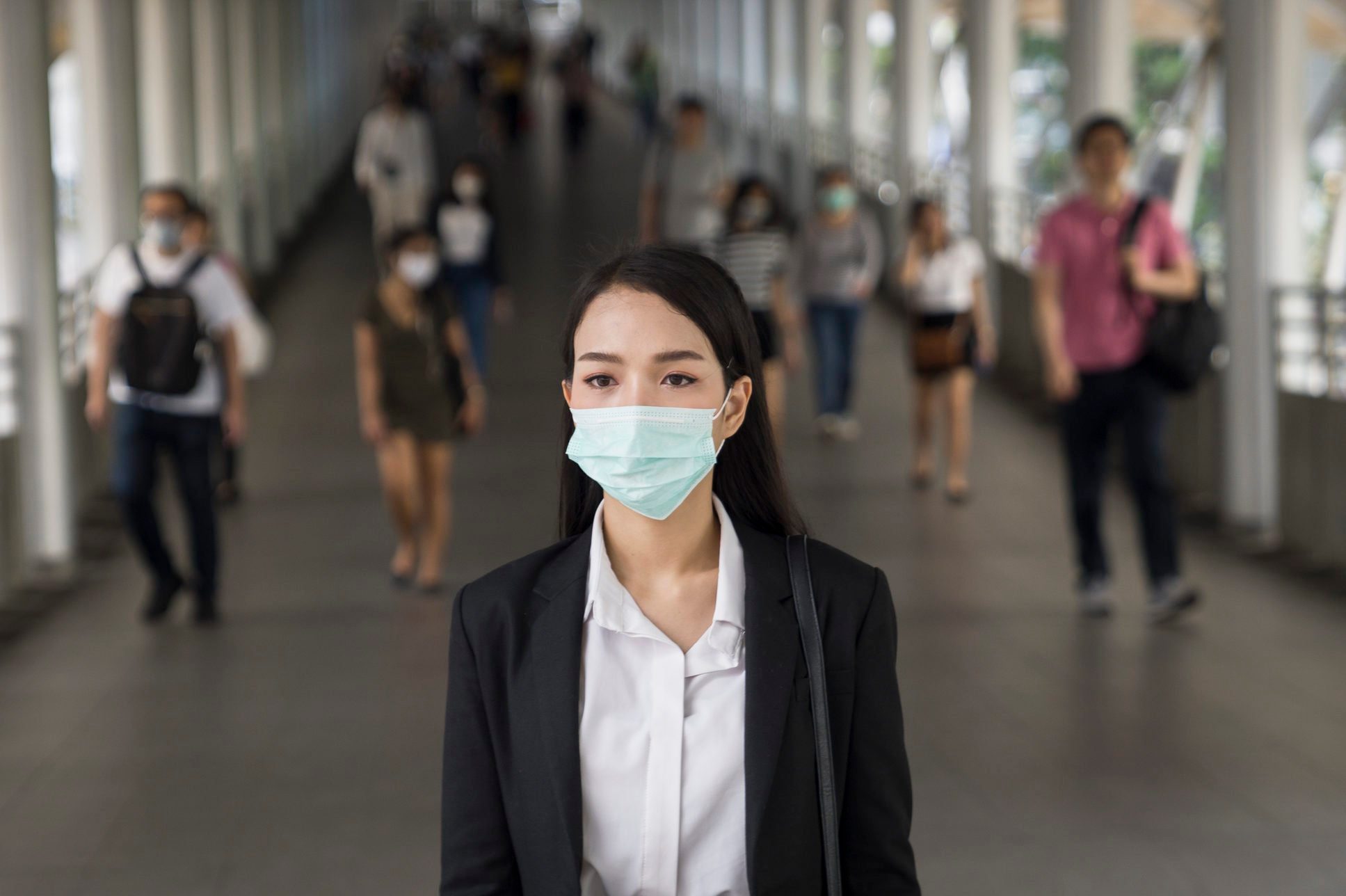
Parts of Canada are beginning to reopen—and people are eagerly venturing out after months of being stuck at home. But that doesn’t mean it’s suddenly safe to socialize the way we used to. With cases of COVID-19 still popping up across the country, it’s important to weigh the risk level of the places you plan to visit during the pandemic.
In general, coronavirus is most likely to spread in “indoor environments with limited fresh air flow, where large numbers of people can gather for longer than 10 minutes of interactions, and where it is difficult to maintain physical distancing,” according to Boris Lushniak, MD, dean of the University of Maryland School of Public Health. When planning your future public outings, experts recommend avoiding these everyday places as best as you can.
Bars and restaurants
“Unfortunately, as bars have reopened, we have seen a large number of young people gathering but not necessarily being wary that COVID-19 is still a problem,” Lushniak say, also noting that even bars that limit capacity and space tables six feet apart are high-risk environments.
People gather as they wait in line to get in, most not wearing masks or social distancing. Inside, people spend hours in a small, poorly ventilated space while dancing, standing close together, and shouting over the music. Loud conversations at bars can release up to ten times as many respiratory droplets as a cough, research has found.
At any indoor spot, Dr. Lushniak suggests taking stock of what public health recommendations are being followed. Ask yourself, “Are people wearing masks? Is the six-foot rule being applied? Is it crowded with people?” he says. Best to turn down any gathering that doesn’t abide by expert-approved safeguards.
Beaches
If you’re looking to beat the heat this summer, you might want to skip the beach. While it’s true that beaches allow more airflow than indoor environments and that there’s little evidence that the virus can spread to people through water, experts believe viral particles can still travel from an infected person to others nearby. What’s more, these particles can linger for hours at a time, like beaches and pools, according to the Centers for Disease Control and Prevention (CDC).
Although experts say the virus is more likely to spread inside, you should still take precautions when visiting outdoor spaces like beaches. The CDC recommends wearing a mask and avoiding crowded areas where you can’t stay six feet apart from other beachgoers.
Places of worship
Churches and other places of worship incorporate many of the practices that experts believe increase the likelihood of transmission. In addition to spending long periods of time indoors, people are congregating close together, sharing food, and speaking and singing loudly.
Most places of worship are holding remote services, but worshipers attending in person should not be afraid to ask about the property’s cleaning and disinfection protocols, according to Dr. Lushniak. “All this is about your personal and your family’s health,” he says.
Gyms and fitness centres
Experts point to insufficient ventilation, large class sizes, and intensity of the workouts for high infection rates at gyms.
If you decide to visit the gym, prepare to mask up. “These practices show we care about our own health but also the health of those around us,” Dr. Lushniak says. “This is the right thing to do and is part of the weaponry to battle the pandemic.”
Family gatherings
If you are feeling sick or have been exposed to COVID-19 in the past 14 days, it’s best to sit out on social gatherings. The CDC also recommends hosting any gathering outdoors or in a well-ventilated space. Spacing tables and chairs six feet apart, planning social distancing-friendly activities, wearing face masks, and frequent handwashing can also help to protect guests from infection.




